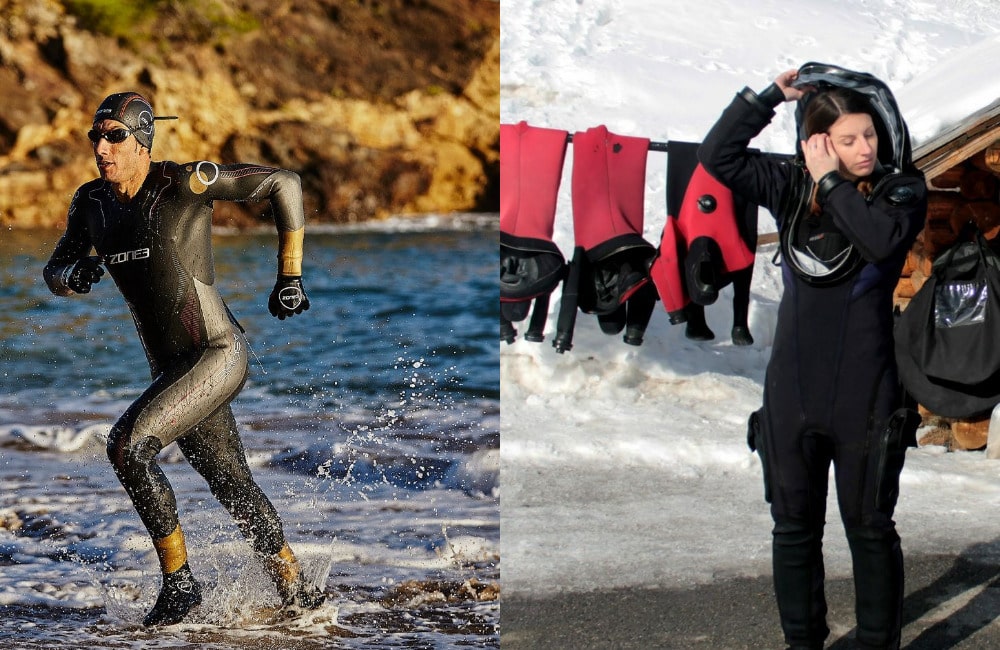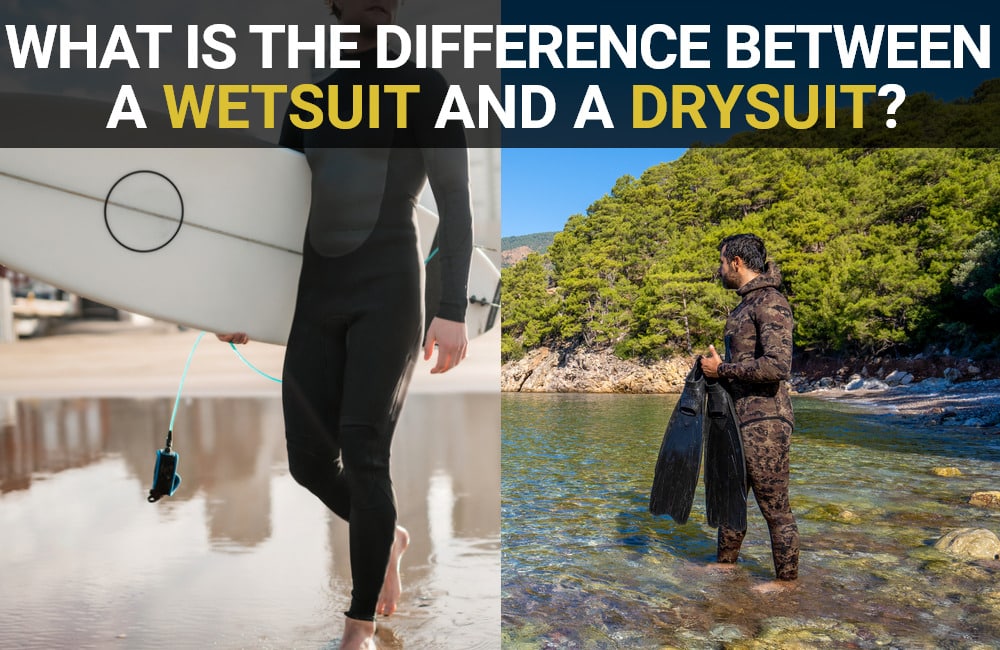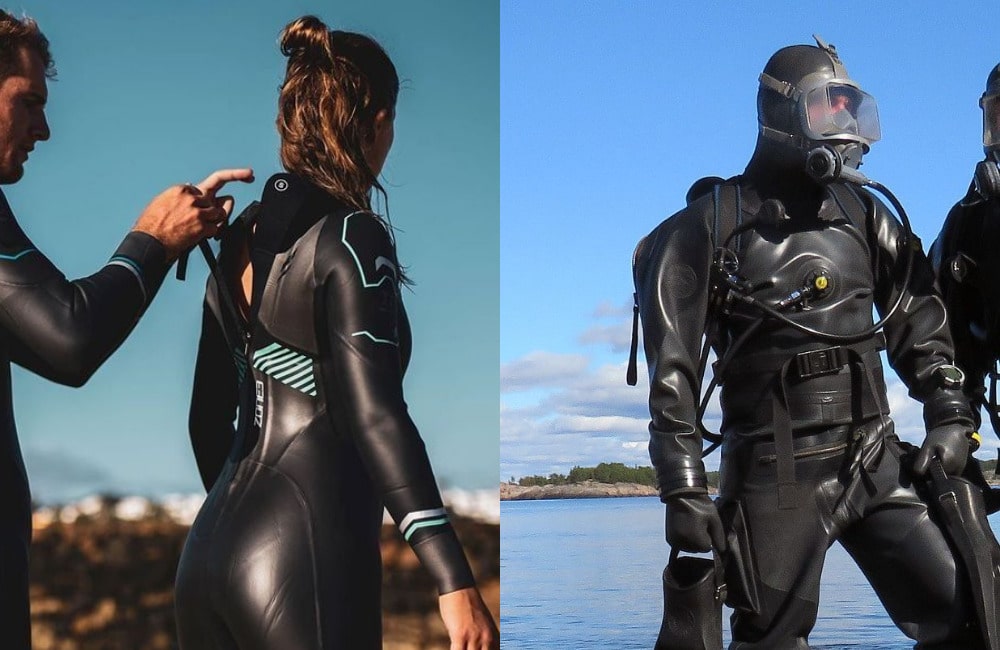Are you wondering about the differences between a wetsuit and a drysuit? Diving, surfing, or spearfishing in cold waters require protective clothing that can help to keep you comfortable and safe. A good understanding of what wetsuits and drysuits are, how they differ from each other, and when to use which, one is key for having an enjoyable time out on the water.
In this blog post, we’ll explore the differences between these two pieces of aquatic apparel; delving into how each work to protect against various elements and at what temperatures they should be used.
Features of Wetsuit and Drysuits
Below, we will explore the features of wetsuit and drysuits separately:
Features of Wetsuits
Following are the complete details of wetsuits and their features in detail:
Definition and Purpose of Wetsuits
Wetsuits are a type of garment worn while participating in water sports that provide insulation and protection from the elements. They are typically made from neoprene, a synthetic rubber that is resistant to water, heat, and oil.
The primary purpose of a wetsuit is to keep the wearer warm by trapping a thin layer of water between the neoprene and skin, which is then heated by the body’s natural temperature. The thickness of the wetsuit varies depending on the water temperature and the length of time one plans to be in the water.
Wetsuits not only keep us warm but also enhance buoyancy and provide protection from abrasions, stings, and sunburn.
Material and Construction
Wetsuits, which provide insulation and protection to surfers, divers, and swimmers in cold water, are primarily made of neoprene, a synthetic rubber material. Neoprene consists of small gas bubbles trapped within a matrix of rubber, which improve buoyancy and insulation properties.
The thickness of the wetsuit varies based on the water temperature at which it will be used. In colder water, thicker wetsuits are needed, while in warmer water, thinner wetsuits are generally used.
This is because the thicker the wetsuit, the more insulating it is. In addition, the construction of wetsuits includes strategic placement of seams and zippers to minimize water leakage and maximize comfort and flexibility.
Mechanism of Insulation
One of the most significant features of wetsuits is their insulation. The mechanism that allows wetsuits to keep the wearer warm in cold water is the trapping of a thin layer of water against the body.
This layer of water is heated by the body’s natural warmth and acts as an insulator, preventing the cold water from coming into direct contact with the skin. The thickness of the wetsuit determines how much of this layer is trapped, and it’s essential to have the right thickness for the water temperature to ensure maximum insulation.
Properly insulating a wetsuit allows for more extended enjoyment of water sports, both in colder temperatures and for longer periods of time.
Suit Design and Fit
The perfect wetsuit should provide warmth, protection, and enhanced buoyancy, all while allowing for ease of movement. For this reason, choosing the right type of suit design and the ideal fit is crucial.
Popular options include full suits, shorties, and spring suits, each offering varying degrees of coverage and insulation. The fit of a wetsuit is equally important, as a tight fit can reduce water circulation and improve thermal effectiveness. While finding the perfect wetsuit may take some trial and error, it ultimately leads to a more fulfilling and enjoyable aquatic experience.
Features of Drysuits
Following we will delve into the complete details of drysuits. Take a look:
Definition and Purpose of Drysuits
Drysuits are a vital piece of equipment for anyone who enjoys water activities in cold temperatures. These suits are designed to keep the wearer dry, even when fully submerged. They are typically made from thick neoprene or latex materials, which provide excellent insulation against the cold.
The purpose of a drysuit is not just to keep you comfortable during your aquatic adventures, but also to ensure your safety. By keeping you dry and warm, these suits help prevent hypothermia and other cold-related injuries.
In addition, drysuits are often used in technical diving and rescue operations, where they are essential for helping divers stay safe and focused in high-pressure, high-stakes situations. With their unique design and specialized features, drysuits are a must-have for anyone who wants to stay safe and comfortable while exploring the underwater world.
Material and Construction
When it comes to drysuits, the material and construction are crucial factors that determine the durability and effectiveness of these suits. One key element is the use of waterproof and breathable layers, which are essential for maintaining dryness while also allowing for proper ventilation.
The waterproof layer is typically made of neoprene, latex, or Gore-Tex, while the breathable layer is made of Gore-Tex or other breathable fabrics. These layers work together to create a suit that not only keeps the wearer dry but also prevents overheating.
Proper maintenance and care of these layers is vital to ensure the longevity and effectiveness of your drysuit. By understanding the significance of materials and construction, you can choose a quality drysuit that meets your needs and keeps you comfortable throughout your aquatic adventures.
Mechanism of Insulation
The mechanism of insulation in drysuits involves sealing the body off from any potential sources of water, creating a closed environment that prevents any entry or exit of liquid. This is achieved through a range of sealing mechanisms, including wrist, neck and ankle seals. By keeping water out, drysuits are able to maintain a warm and dry environment that is essential for comfort and safety in cold or harsh conditions.
Suit Design and Fit
With a wide variety of drysuit designs available, it’s important to choose one that suits your needs. When considering a drysuit, consider the design options available. One-piece suits with integrated boots are popular and minimize the risk of water entering the suit via the boots.
Alternatively, separate boots and gloves may offer better flexibility and customization. It’s worth noting that looser fit suits are common, allowing for easier layering and insulation. Finding the perfect fit may require trial and error, so it’s important to have patience and understanding while shopping for a drysuit.
Key Differences Between Wetsuits and Drysuits

Following are the key differences between wetsuits and drysuits:
Insulation Mechanism:
One of the most significant differences is their insulation mechanism. Wetsuits rely on trapping a layer of water between the suit and the skin to create a warm and waterproof barrier. On the other hand, drysuits maintain a dry layer by preventing any water from getting inside the suit in the first place.
Both methods have their pros and cons, but understanding how each suit works can help you make an informed decision based on your personal needs and preferences.
Water Temperature Suitability
One of the major factors to consider is the water temperature you’ll be diving in. Wetsuits are designed to keep you warm in milder waters, where the temperature is unlikely to dip too low. Their neoprene material provides insulation and helps to retain body heat, making them ideal for activities such as surfing, snorkeling, and diving in the tropics.
However, for colder water diving, a drysuit is a much better option. These specialist suits incorporate seals at the wrists and neck to prevent water from entering and can be combined with insulating under layers to keep you comfortable and dry in frigid conditions.
Ultimately, whether you opt for a wetsuit or drysuit will depend on your diving preferences and the climates in which you’ll be diving.
Mobility and Flexibility
When it comes to selecting between wetsuits and drysuits, mobility and flexibility are essential factors to consider. While both wetsuits and drysuits offer insulation and resistance to cold water, their design features distinct differences in terms of flexibility.
Wetsuits offer more flexibility, allowing the wearer to move with ease and without hindrance. On the other hand, drysuits can restrict movement due to their bulkiness. However, some drysuits come with adjustable seals and stretch neoprene materials that provide some level of flexibility.
Buoyancy
Beyond differences in construction and materials, one important factor to consider is buoyancy. Wetsuits provide some buoyancy due to the trapped water within their neoprene material. This can aid in keeping you afloat and reducing overall fatigue.
Drysuits, on the other hand, require proper weighting due to their air insulation. Ensuring you have the correct weight distribution is key to achieving neutral buoyancy and a comfortable, streamlined dive. By taking into account the buoyancy differences between the two suits, you’ll be on your way to a successful and enjoyable venture.
Application and Considerations of Wetsuits and Drysuits

Following are the application and consideration of wetsuits and drysuits:
Wetsuits
Primarily used for activities such as surfing, snorkeling, and warm-water diving, these suits can make a significant difference in your comfort level while in the water. When it comes to maintenance, proper care is crucial for extending the life and effectiveness of your wetsuit.
Ensure its rinsed with freshwater after each use and hung dry away from direct sunlight or heat sources. Regularly check for damage and repair any tears or holes immediately to avoid further complications. By taking proper care of your wetsuit, you’ll enjoy the benefits of this valuable accessory for years to come.
Drysuits
Drysuits are an essential piece of equipment for cold-water diving and professional divers. The application of a drysuit allows for divers to remain warm and dry while exploring chilly underwater environments.
However, it is important to note that proper training and understanding of this equipment is crucial in ensuring safe and successful dives. As such, individuals may want to consider enlisting in a training program or diving course to learn about the proper use and handling of drysuits.
Additionally, maintaining and caring for this equipment is equally important for prolonging its lifespan and maintaining its effectiveness. Simple tips, such as rinsing with freshwater after each use and storing in a dry, cool place, can make all the difference. Overall, understanding the application and considerations of drysuits is key in ensuring safe and successful diving experiences.
In a Nutshell
As you can see, the differences between a wetsuit and a drysuit are major. Both are used in different water conditions and levels of temperature. When figuring out which one to use, it is important for you to know where and when you will be using it. Wetsuits will keep you warm during a long period of time in colder waters whereas drysuits will protect your body from getting wet due to its waterproof features.
Overall, both suits the purpose of keeping people safe and comfortable while doing regular water activities. People looking for warmth should think about buying a wetsuit whereas people looking for protection should go for a drysuit.
Additionally, if possible, try them on before purchasing so that you can find the suit that best fits your needs and body type. That way, no matter what kind of clothes you decide to invest into, you’ll have great sessions by staying safe and happy on the water.

